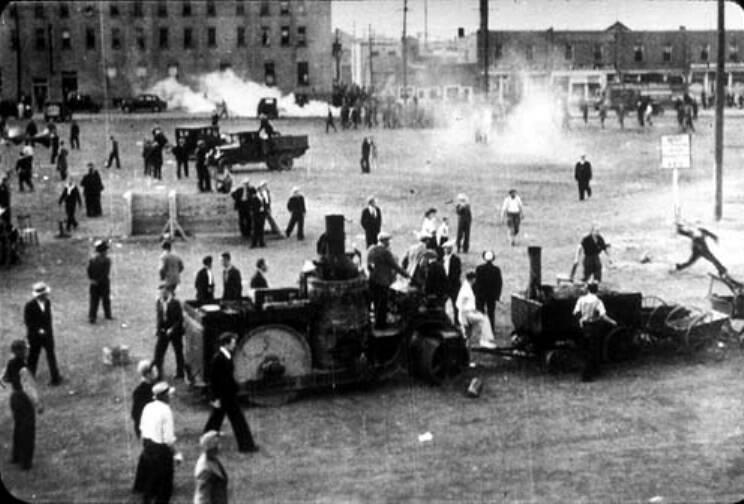Ninety years ago, 1,000 men from British Columbia’s Depression-era relief camps climbed aboard a freight train in Vancouver and headed toward Ottawa.
The men had been gathered in Vancouver since April, protesting work conditions in the camps. By moving the protest eastwards, the leaders of the “On-to-Ottawa Trek” hoped to meet with the federal government of the day to demand better camp conditions and a fairer way to address unemployment.
The trek was to trigger a riot in Regina, government coverup and electoral defeat, and the first program of what would become the social safety net that Canadians today rely on and love to complain about.
Set up to deal with the huge numbers of unemployed men in the country’s cities during the Depression, by 1935, nearly 150 relief camps operated across Canada. More than one-third were located in B.C.
During the camps’ 44-hour workweek, the men built roads, airports and other public infrastructure for as little as 20¢ per day — well below the minimum wage in any province at the time. Room and board were provided, but most of the communal huts the men slept in were uninsulated and unheated or lacking sufficient fuel for warmth. Meals were regular but consisted largely of unappetising army rations and similar fare. Strict rules governed the men’s conduct, visitors and free-time activities.
Many Canadians supported the strikers. In Vancouver, 20,000 residents attended a picnic organized by locals to raise money for the men. From the time they left Vancouver on June 3, 1935, the On-to-Ottawa trekkers attracted recruits and supporters along their route. Communities and city and even provincial authorities along the route donated food and supplies to support them — while encouraging them quietly to move on. The local press called them “our boys,” and local residents sympathized.
By the time they reached Regina, the trekkers numbered 2,000.
But the federal government saw them as a communist menace. In Regina, the feds forbade the railways to take the men further. A delegation of eight strike leaders invited to continue to Ottawa to meet with then-Prime Minister R.B. Bennett were accused of insurrection and rebellion. Regina-area RCMP also saw them as a threat and readied a specially prepared camp outside the city to send the men to.
When they returned to Regina at the end of June, the trek leaders promised to disband the strike if all of the trekkers were allowed to leave Regina. After hours of discussions with local officials, trek leaders called an evening meeting for July 1.
Most of the trekkers elected instead to attend a Canada Day baseball game held for them elsewhere in the city, but in a show of peaceful protest and solidarity with the men’s situation, nearly 2,000 locals joined a few hundred trekkers in the city’s downtown Market Square.
As the meeting began, 400 police poured into the square, armed with baseball bats, clubs, teargas and guns. They chased people into surrounding streets.
The ensuing riot raged for more than six hours throughout the downtown core.
Seventeen people — including five locals — were injured by police gunfire in what is now called the Regina Riot. Businesses were burned. More than 100 people went to hospital or were taken into private homes. One trekker and one policeman died.
Bennett announced that the On-to-Ottawa trek was a “revolutionary effort on the part of a group of men to usurp authority and destroy government” and later endorsed an inquiry that absolved the police authorities of any wrongdoing. However, during the lengthy trials that followed, no evidence was produced to show that strikers fired shots during the riot. In the days after the riot, the Saskatchewan government blamed Ottawa and the police for provoking the violence and, as a goodwill gesture to the trekkers, offered the men free transportation home or back to the B.C. camps.
That fall, Bennett lost the federal election. The camps closed, and measures addressing the plight of the Great Depression’s unemployed were put in place.
Other countries also experienced the Depression and its staggering levels of poverty and unemployment. Other countries also saw transient people travelling the rails in search of food, work and better conditions. Other countries also put in place relief programs — camps, work projects, food programs.
But in Canada, some of the programs inspired by the Depression — and the On-to-Ottawa Trek — lasted. In 1940, as the Depression made way for the Second World War, the federal government passed the Unemployment Insurance Act, establishing the first national program in the social safety net we know today.



